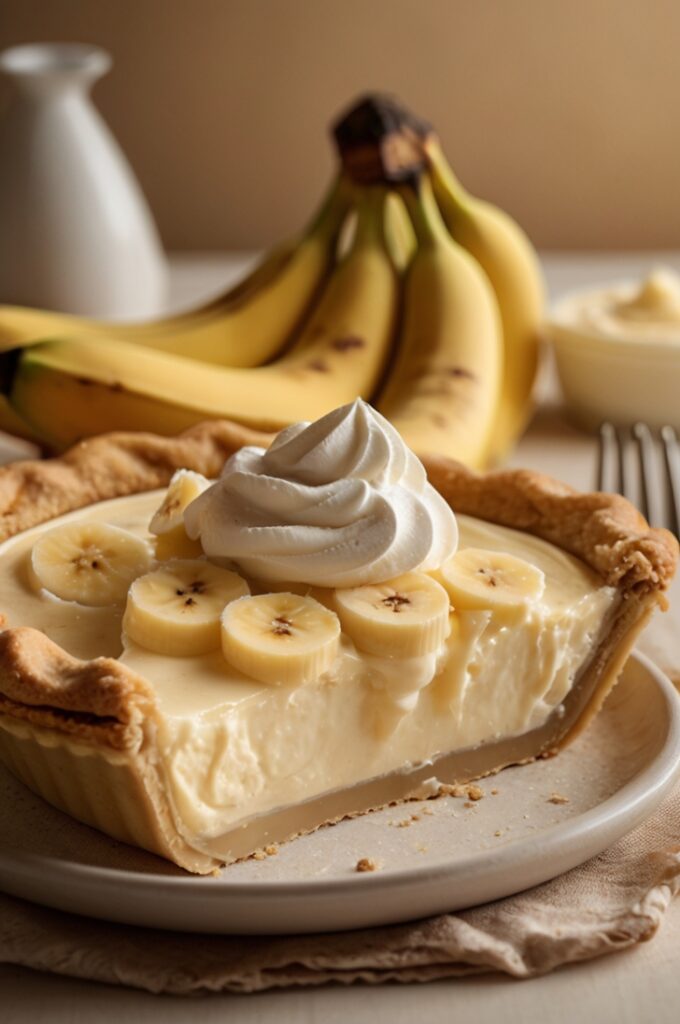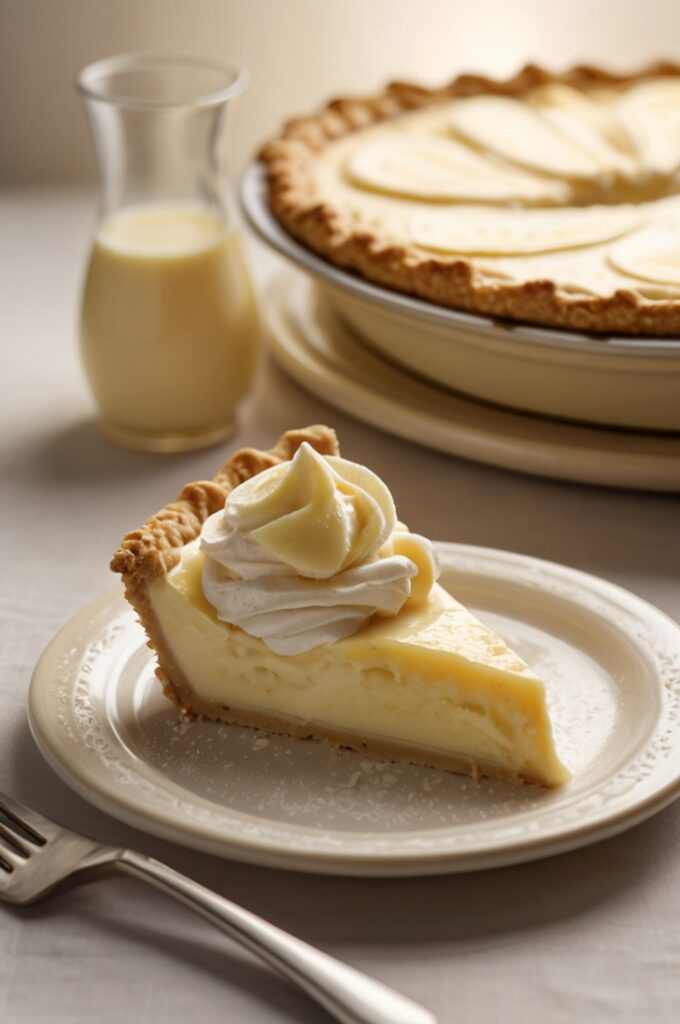My grandmother’s hands moved with practiced precision as she whipped the custard for her legendary banana cream pie. I was eight years old, standing on a wooden stool beside her, mesmerized by the transformation happening before my eyes. “The secret,” she whispered, “is patience.” Thirty years and countless pies later, I’ve never forgotten that lesson. Its one of those culinary truths that transcends recipes.
Banana cream pie occupies a special place in American dessert culture. This luscious creation—with its buttery crust, velvety custard, fresh bananas, and cloud-like whipped topping—balances simplicity and sophistication in perfect harmony. It’s comfort food elevated to an art form. What makes this classic so enduring isn’t just its deliciousness, but its ability to showcase basic ingredients in their most glorious form.
Let’s demystify this beloved dessert and reveal how to craft a banana cream pie that would make any pastry chef proud.
1. Ingredients & Substitutions
For the Crust:
- 1½ cups graham cracker crumbs (about 10 full sheets)
- 7 tablespoons unsalted butter, melted
- ⅓ cup granulated sugar
- ¼ teaspoon kosher salt
Alternatively, a traditional pie crust works beautifully. For those navigating gluten concerns, almond flour combined with crushed gluten-free cookies makes an exceptional substitute. The slight nuttiness actually complements the banana flavors wonderfully.
For the Custard:
- 4 large egg yolks
- ¾ cup granulated sugar
- ¼ cup cornstarch
- ½ teaspoon fine sea salt
- 3 cups whole milk
- 2 tablespoons unsalted butter
- 2 teaspoons pure vanilla extract (or 1 vanilla bean, split and scraped)
Custard quality depends enormously on your dairy choice. Whole milk provides the ideal balance of richness and lightness, but you could substitute half-and-half for added decadence. Plant-based milks can work, but oat milk tends to produce the most comparable results—just expect a slightly looser set.
For Assembly:
- 4-5 ripe bananas (with slight brown spotting for maximum flavor)
- 2 cups heavy whipping cream
- 3 tablespoons confectioners’ sugar
- 1 teaspoon vanilla extract
- Optional: 2 tablespoons dark rum or 1 tablespoon banana liqueur
The bananas are arguably the most critical component—yet often the most overlooked. They should be ripe but still firm, with light browning on the peel indicating peak sweetness. Green-tipped bananas lack depth and will leave your pie tasting flat and starchy.
2. Step-by-Step Instructions

Preparing the Crust:
- Preheat your oven to 350°F (175°C). Combine graham cracker crumbs, melted butter, sugar, and salt in a mixing bowl until the mixture resembles wet sand. The texture here is crucial—too dry and it won’t hold shape; too wet and it’ll become leathery when baked.
- Press the mixture firmly into a 9-inch pie plate, using a flat-bottomed measuring cup to compact it evenly. Starting from the center and working outward creates the most consistent thickness. Don’t rush this step—a properly formed crust is the foundation of your entire pie.
- Bake for 8-10 minutes until fragrant and lightly golden. Cool completely on a wire rack before filling. Many bakers underestimate the importance of thorough cooling—a warm crust will cause condensation that makes the bottom soggy.
Crafting the Custard:
- In a medium bowl, whisk egg yolks thoroughly until lightened in color. Set aside within easy reach of your stovetop. Room temperature yolks incorporate more smoothly than cold ones, so plan accordingly.
- In a heavy-bottomed saucepan, whisk together sugar, cornstarch, and salt. Gradually whisk in the milk, ensuring there are no lumps. This sequential addtion prevents those frustrating cornstarch clumps that refuse to dissolve.
- Cook over medium heat, whisking constantly (not occasionally—constantly!), until the mixture begins to thicken and bubble. This typically takes 7-9 minutes, depending on your stove. When large bubbles break the surface, continue cooking for exactly 2 more minutes.
- Temper the egg yolks by gradually whisking about 1 cup of the hot mixture into the yolks. This prevents the eggs from scrambling and ruining your custard. Then, pour the yolk mixture back into the saucepan, whisking continuously.
- Return to heat and bring just to a simmer, whisking constantly as the custard thickens—about 2-3 minutes. It should coat the back of a spoon and leave a clean line when you run your finger through it. Remove from heat immediately to prevent overcooking.
- Stir in butter and vanilla until fully incorporated. The butter adds silkiness while the vanilla enhances the banana flavor. Transfer to a bowl and press plastic wrap directly onto the surface of the custard to prevent a skin from forming. Chill thoroughly, at least 3 hours or overnight.
Assembly:
- When ready to assemble, slice bananas into ¼-inch rounds. Too thin and they’ll disintegrate; too thick and they’ll disrupt the textural harmony of the pie. If using rum or liqueur, toss banana slices gently to coat—this not only adds flavor but also helps prevent browning.
- Spread a thin layer of custard on the bottom of the cooled crust. This creates a moisture barrier that helps maintain crispness. Arrange a layer of banana slices over this foundation, overlapping slightly.
- Pour half the remaining custard over the bananas, spreading to the edges. Add another layer of bananas, then top with the remaining custard. The layering technique creates pockets of banana throughout rather than concentrated at the bottom.
- Whip heavy cream with confectioners’ sugar and vanilla until medium-stiff peaks form. Dont overwhip—you want billowy clouds, not butter. Spread or pipe over the pie, creating decorative swirls if desired.
- Refrigerate for at least 2 more hours before serving. This final rest allows the flavors to meld and textures to harmonize. For garnish, consider a few thin banana slices (dipped in lemon juice to prevent browning) or chocolate shavings.
3. Cooking Techniques & Science
The magic of banana cream pie lies in understanding the science behind its components. The custard, technically a stirred pastry cream, thickens through a process called gelatinization. When starch granules from the cornstarch are heated in liquid, they absorb water, swell, and eventually burst, releasing amylose molecules that create a network throughout the mixture.
Egg yolks serve dual purposes—they enrich the custard with fat and lecithin (a natural emulsifier) while contributing proteins that coagulate upon heating to enhance the custard’s structure. The precise balance between cornstarch and eggs determines whether your custard will be delicately silky or firmly sliceable.
Temperature control is non-negotiable when making custard. Too low, and gelatinization occurs unevenly; too high, and the eggs will curdle. A candy thermometer isn’t strictly necessary, but it helps—aim for a final temperature between 180-185°F (82-85°C).
Bananas themselves undergo fascinating changes during ripening. As they yellow and develop spots, their starches convert to sugars, particularly sucrose, glucose, and fructose. This process peaks when the peel shows small brown spots—precisely when their flavor profile offers the perfect balance of sweetness and banana essence.
A copper or stainless steel bowl makes whipping cream significantly easier, as the metal conducts cold better and helps maintain the low temperature necessary for stable whipped cream. If piping the topping, consider stabilizing it with a small amount of gelatin or mascarpone cheese to maintain those beautiful decorative elements for longer periods.
4. Serving & Pairing Suggestions
Banana cream pie achieves its full potential when served cool but not refrigerator-cold—about 30 minutes out of the fridge allows the custard to soften slightly and the flavors to bloom. Slice with a hot, clean knife for the cleanest presentation, wiping between cuts.
For plating, consider a pool of warm salted caramel sauce beneath each slice, creating a temperature and flavor contrast that elevates the entire experience. A light dusting of cocoa powder or a sprinkle of toasted coconut adds visual interest and textural complexity.

Beverage pairings matter tremendously with such a rich dessert. A bright, acidic coffee (particularly an Ethiopian natural process with berry notes) cuts through the creaminess while complementing the banana’s natural sweetness. For wine enthusiasts, a late-harvest Riesling or Tokaji provides the necessary acidity and complementary fruit notes without overwhelming the delicate flavors.
Consider serving smaller slices alongside fresh berries—particularly raspberries or blackberries, whose tartness provides counterpoint to the pie’s richness. If serving as the finale to a dinner party, precede it with a lighter main course to avoid palate fatigue.
Conclusion
Banana cream pie may seem like a simple dessert, but its brilliance lies in that very simplicity—basic ingredients transformed through technique into something transcendent. The difference between a merely good pie and an exceptional one often comes down to subtleties: proper tempering, attentive stirring, and above all, quality ingredients handled with respect.
Remember that patience your grandmother might have taught you. It applies at every stage—waiting for bananas to reach ideal ripeness, taking the time to properly temper eggs, allowing components to cool completely before assembly. These seemingly small details compound to create pie perfection.
Whether you’re making this classic for a casual family gathering or an elegant dinner party finale, this approach elevates banana cream pie beyond nostalgia to something truly worthy of celebration. Its a dessert that reminds us that sometimes, the most familiar flavors can still surprise and delight us.
FAQs
Why does my custard sometimes curdle or become lumpy?
This typically happens when eggs are added too quickly to hot liquid or when the mixture gets too hot. Always temper your eggs by slowly adding hot liquid while whisking constantly, and never let your custard boil vigorously. If disaster strikes, sometimes quickly straining through a fine-mesh sieve can rescue it.
How can I prevent my bananas from turning brown in the pie?
Brush your banana slices lightly with lemon juice or pineapple juice before assembly—the acid prevents oxidation without significantly altering flavor. Alternatively, assemble your pie as close to serving time as possible, ensuring the bananas are completely covered by custard.
My graham cracker crust often gets soggy. What am I doing wrong?
Three common culprits: not baking the crust long enough initially, not cooling it completely before filling, or not creating that thin protective layer of custard before adding bananas. You might also consider “sealing” the cooled crust with a thin layer of melted white chocolate before assembly.
Can I make banana cream pie in advance for a party?
While best enjoyed within 24 hours of assembly, you can prepare components separately in advance. The crust and custard can be made 2-3 days ahead and stored separately. Assemble with bananas and topping up to 12 hours before serving, keeping refrigerated.
What’s the secret to getting a perfectly sliceable pie rather than one that falls apart when served?
Thorough chilling is key—at least 6 hours for the assembled pie. Also, proper custard thickness (not skimping on cornstarch) and using bananas that are ripe but still firm will contribute to clean slices. Finally, cut with a thin-bladed knife dipped in hot water and wiped clean between slices.

